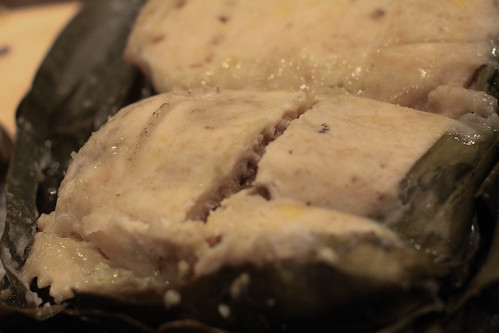The same geographic isolation that's led to the lemurs and other unique fauna and flora for which most of us know this island, also meant that even though it's not far on an absolute basis from where humankind emerged in East Africa, it wasn't settled until around 2,000 years ago. And, improbably, those settlers were Austronesian, probably from Borneo, having crossed the Indian Ocean westward in canoes — in other words, from the same ethnic core as Hawaiians and even Easter Islanders. As they did wherever they went, those Austronesians brought rice and pork with them, too.
Madagascar is so big — the fourth-largest island in the world — that before Europeans showed up, the folks living there didn't have a name for it. So there was nobody to tell Marco Polo that he really messed up when he confused the island with Mogadishu, the port city and current capital of Somalia, and then got it really wrong. So while Madagascar is indeed an exotic-sounding name, it was accidentally invented by a Venetian.

Our guest of honor was Mimi, from Madagascar, who helped us plan the meal and also help us understand what we were eating and why. We also had his wife Kirsten, their son, and Deena, Bengt, Molly, Julie, Levi Laura, Anna, Judy, Haley, and Mary — a big enough crowd that we needed two whole tables!
Vary | Rice
The basis of virtually every Malagasy meal, it’s typically served in tremendous quantities. I’m figuring its predominance is a legacy of the Austronesians. Despite its importance, I couldn’t find any description of how they cook it; Mimy said to just do the “normal” method of bringing to a boil then steaming.
Ranovola | Rice water
The water in Madagascar isn’t safe to drink, so you need to boil it. But the big pot was just used for making a bunch of rice, and it’s a pain to scrub off the bits of rice stuck to the bottom. The Malagasy solution is brilliant: just boil the water in the pot along with the stuck-on bits! The water gets a delightful toasty flavor, and the pan is a lot easier to clean.
You can drink this rice water warm or chilled; I chilled it. The flavor was indeed nice and nutty, though Mimy suggested I could have boiled it a bit longer to make the flavor even deeper.
Ravitoto sy henakisoa | Pork with cassava leaves | Recipe

Pork from the Austronesians and cassava from the African mainland (after having been originally brought from Brazil) combine to make a national dish that’s very emblematic of Madagascar’s cultural geography. I have to admit that cassava-leaf stews just aren’t my favorite, though to be fair I’ve only had them made from rock-hard chunks of frozen leaves, which can’t be ideal. That said, this was among the better I’ve had, the pork definitely adding a richness that central African preparations have tended to lack.
Tsaramaso | Beans | Recipe

Unlike several other African bean dishes I've made, which are very straightforward preparations with just a few vegetables for flavor, this one has two features that make for more flavor. The first is cooking the vegetables first and making a broth out of that, so the flavors can be absorbed throughout cooking rather than just mixed in at the end. The second is some seasoning, in the form of curry — perhaps we can thank trading ships on the Indian Ocean for that contribution. It went extra well with some fried tilapia, which probably should have been whole filets but ended up as pieces due to a bit of kitchen miscommunication. Oh well! All tasty over the requisite pile of rice.
Ro mazava | Broth | Recipe

When there's not much money or food around, a meal may consist solely of some rice supplemented by a weak broth of greens or maybe some bits of fish or meat. In my enthusiasm to incorporate a broad variety of Malagasy foods, I kinda went overboard, and made a broth of greens and fish in addition to the whole rest of the meal. Mimy said you probably wouldn't serve such a broth if you have other stuff, but all the same, it added some nice flavor to drink it warm alongside the meal.
Sakay | Hot sauce | Recipe (in French)
What a surprisingly successful condiment, especially considering I couldn't find a single recipe that gave proportions. To translate the linked recipe interpreted by what I did: equal parts by volume of garlic and black pepper (since there seems to be nowhere in the US to get the specified Voatsiperifery pepper), and a little less of bird's eye chilies (I used frozen ones from the Asian grocery). I threw in enough vinegar and oil to make a smooth texture, dashed in a bit of dried ginger and salt, and whizzed it up in the little food processor. The abundant black pepper gives it an unusual and intense dimension, and most importantly, Mimy said he loved it! We ran out, and
Mofo akondro ou koba | Steamed banana and peanut cake | Recipe

Fried desserts are a delicious treat, but really annoying for a chef who also wants to enjoy the dinner party rather than clean up the kitchen and spend time away from the guests wrangling hot oil. So, instead of the fried bananas which seem to be Madagascar's number one dessert, I went for another that can thankfully be made ahead of time: a batter of mashed bananas and rice flour spread onto banana leaves, wrapped around ground peanuts, and poached for a long time (I used the crock pot). The texture firmed up as it was supposed to, but it was pretty bit bland, and Mimy pointed out how it should be improved: put caramelized sugar in with the peanuts! Makes sense to me.